繊細な文化遺産をめぐる旅:発見、保存、発信
表題のページ
| この写真展はウィキメディアとUNESCOが共催し#Unite4Heritageキャンペーンの一環として開催されました。ライセンスフリーでオープンアクセスのデジタル画像から、人類共通の文化遺産の豊かさと多様性を描いたものを集めています。繊細で美しい文化遺産にスポットライトを当て、将来の世代のためにその保護と発信を支えることができればと実施されました。
|

|
| Gilles Mairet撮影、CC BY-SA 3.0ライセンスによる公開(出典:ウィキメディア・コモンズ)
|
| ジェンネ旧市街
|
| ジェンネには紀元前250年ころから人が住み始め、交易の中心として、またサハラ砂漠圏の金取り引野重要な交易路の中継点として発展しました。15世紀から16世紀にかけてイスラム教布教の拠点のひとつでもありました。伝統的な建物群は現在もおよそ2,000件が伝世しており、季節性の川の氾濫に備えるため塚の上に建てられました。このマリアン世界遺産の保護区域には政情不安の影響が及んでおり、この地点は2016年以降、危険にさらされた世界遺産のリストに掲載されています。
|
|
この文章の一部もしくは全文はhttp://whc.unesco.org/en/news/1520に掲載された「ジェンネ旧市街」の記事の内容に依拠しています。CC BY-SA 3.0.ライセンス。
|
写真展について
| 世界の文化遺産と文化多様性を賞賛し保護することが#Unite4Heritage運動の目標であり、不寛容と分裂主義に立ち向かうよう広く皆さんに呼びかけています。
意図的な破壊や過失、観光客の集中と無制限の経済開発、無知と不十分な維持管理によって、人類の文化遺産や多様性が脅かされてしまいます。ユネスコとウィキメディア・スウェーデン協会、ウィキメディア・イタリア協会は連携し、写真を通した文化遺産保存の重要性を強調することで遺産の保護や文化的自己同一感を保ち、共通の未来を築こうとしています。遺産の画像の価値化と一般大衆が利用可能な情報提供により、ユネスコとウィキメディアは遺産を喪失するリスクの軽減、人々を支えて文化的多様性を祝福し、よりよい保護の実施と誇りを持てるよう支援できると考えています。この展覧会では共通の文化遺産のもろさをさまざまな形で展示するため – ライセンスフリーでオープンアクセスの画像を利用しています。これら画像は博物館や公文書館および一般の人々を対象に、ウィキペディアのメディア専門サイトとしてウィキメディア・コモンズ(Wikimedia Commons)の場でさまざまなソースによって共有されています。ウィキメディア・コモンズでは数百万件の画像がライセンスフリーで提供され、誰でも使用したり適用したりする機会を得ることができます。数千人のボランティアがコレクションの維持と改善を担当しています。一般市民はさまざまな種類の文化遺産に関する写真コンテストに参加でき、建築文化遺産の「Wiki Loves Monuments」、アフリカの無形文化遺産の「Wiki Loves Africa」、自然遺産の「Wiki Loves Earth」などがあります。詳細はtinyurl.com/wikilovesを参照してください。参加の場としてウィキペディアやウィキメディア・コモンズ、Unite4Heritageなどがあります。
|
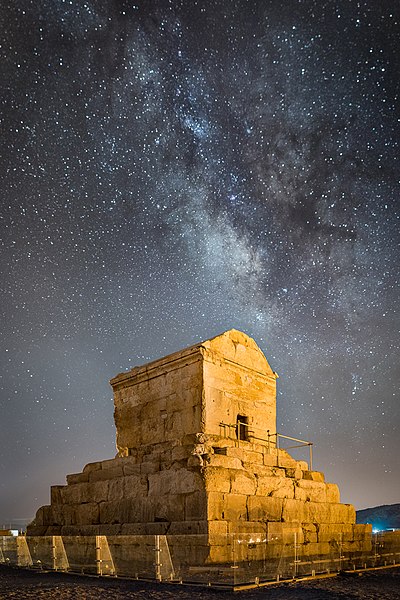
|
| Mohammad Reza Domiri Ganji撮影、CC BY-SA 4.0ライセンスによる公開(出典:ウィキメディア・コモンズ)
|
| イラン・イスラム共和国: パサルガダエ
|
| パサルガタエは西アジア初の偉大な多文化帝国の首都でした。地中海東部からエジプト、インダス川流域にわたり、異なる民族の文化的多様性を尊重した最初の帝国であると考えられています。面積160ヘクタールの敷地には特に注目すべき遺跡があり、要塞のようなテラス式のキュロス2世の霊廟や、王宮の施設群として城門や宮殿、庭園などがあります。さまざまな文化を取り入れたアケメネス朝の建築様式を反映した遺跡は、2004年に世界遺産に登録されました。物理的要因や化学的要因に加えて環境要因による侵食のほか、さまざまなリスクに直面しています。農業や洪水が遺跡に与えるリスクは、考古学的発掘調査で増大され、破壊行為による損害にも見舞われています。
|
|
この文章の一部もしくは全文はhttp://whc.unesco.org/en/list/1106に掲載された「パサルガダエ」の記事の内容に依拠しています。CC BY-SA 3.0.ライセンス。
|
About the Connected Open Heritage project
| Connected Open Heritageプロジェクトはウィキメディア・プロジェクトを介して、脅威にさらされた文化遺産についてライセンスフリーのオープンアクセスの情報を可能な限り多く集めて連携することを目指しています。全世界のボランティアの作業に基づいて構築されました。
一般の人々や意思決定機関の職員が貴重な文化遺産に関する信頼に足りる情報を簡単に入手できるようになると、遺産が保護される可能性が高まります。
国家によって保護された文化遺産の公式データセットの追加により、また博物館や公文書館の収蔵および一般市民による遺産の歴史的画像をデジタル化することで、ウィキペディアの記事が改善されると考えられます。これまで以上に簡単に世界の文化について知識を深めることが可能になります。
Connected Open Heritageプロジェクトはスウェーデン語版ウィキメディアとユネスコ、イタリア語版ウィキペディアが連携し - Gruppo Archeologico Romano及びDecArch社 - さらに Cultural Heritage without Borders(国境なき文化遺産)が参加して実施しています。プロジェクトはスウェーデンの郵便宝くじ文化財団によって資金助成と支援を受けています。
プロジェクトについてもっと詳しく知るには: tinyurl.com/ConnectedOpenHeritage
|

|
| Photo by Aivaras Ramanauskas, CC BY-SA 2.0, via Wikimedia Commons
|
| アフガニスタン:ジャームのミナレットと
考古遺跡群
|
| The 65 meter tall Minaret of Jam is a graceful, soaring structure, dating back to the 12th century. Covered in elaborate brickwork with a blue tile inscription at the top, it is noteworthy for the quality of its architecture and decoration, which represent the culmination of an architectural and artistic tradition in this region. Its impact is heightened by its dramatic setting, a deep river valley between towering mountains in the heart of the Ghur province. The site is inscribed in the List of World Heritage in Danger since 2002. Erosion of the riverbanks adjacent to the Minaret, any further movement in the level of inclination of the monument along with any degradation in the historic fabric of the site in general need to be monitored.
|
|
この文章の一部もしくは全文はhttp://whc.unesco.org/en/list/211に掲載された「ジャームのミナレットと考古遺跡群」の記事の内容に依拠しています。CC BY-SA 3.0.ライセンス。
|
Unite4Heritage
In 2015, in response to the unprecedented attacks on cultural heritage, UNESCO launched the advocacy campaign #Unite4Heritage at the University of Baghdad. In 2019, by establishing partnerships with key stakeholders and strengthening digital communication, #Unite4Heritage is mobilizing a wider public, especially young people, on a truly global level.
In 2017, by establishing partnerships with key stakeholders and strengthening digital communication, #Unite4Heritage is mobilizing a wider public, especially young people, on a truly global level. This exhibition, in collaboration with Wikimedia Commons, displays three pillars of the movement: built heritage; intangible cultural heritage; and heritage collections and the fight against illicit trafficking. Since its establishment, UNESCO has been consistently dedicated to the cause of culture and development. Focus has been on coordinating international cooperation, strengthening the ties between nations and societies, and mobilizing the public. The aim is to ensure that every citizen can grow and live in a cultural environment rich in diversity and dialogue, where heritage serves as a bridge between generations and peoples.
This exhibition, in collaboration with Wikimedia Commons, will display three themes of the movement: built heritage; intangible cultural heritage; and heritage collections and illicit trafficking, highlighting the spirit of the movement. These themes also represent the work of UNESCO Culture Conventions, including:
- The 1970 Convention Concerning the Means of Prohibiting and Preventing the Illicit Import, Export and Transfer of Ownership of Cultural Property.
- The 1972 Convention Concerning the Protection of the World Cultural and Natural Heritage.
- The 2001 Convention on the Protection of the Underwater Cultural Heritage.
- The 2003 Convention for the Safeguarding of the Intangible Cultural Heritage.
Let’s unite for our common heritage and transmit its values to our future generations!
|

|
| Photo by Martin St-Amant, CC BY-SA 3.0 via Wikimedia Commons.
|
| Peru: Historic Sanctuary of Machu Picchu
|
| Historic Sanctuary of Machu Picchu stands 2,430 m above sea-level, in the middle of a tropical mountain forest, in an extraordinarily beautiful setting. It was probably the most amazing urban creation of the Inca Empire at its height; its giant walls, terraces and ramps seem as if they have been cut naturally in the continuous rock escarpments. The natural setting, on the eastern slopes of the Andes, encompasses the upper Amazon basin with its rich diversity of flora and fauna. It was inscribed on the World Heritage List in 1983. Tourism represents a double-edged sword to Machu Picchu by providing economic benefits but can also result in cultural and ecological impacts.
|
|
この文章の一部もしくは全文はhttp://whc.unesco.org/en/list/274に掲載された「マチュピチュの歴史的聖域」の記事の内容に依拠しています。CC BY-SA 3.0.ライセンス。
|
An exhibition by
The following organisations have been working in partnership to organise this photo exhibition:
- UNESCO – United Nations Educational, Scientific and Cultural Organization was created to contribute to peace and security by promoting international collaboration through education, science, and culture in order to increase universal respect for justice, the rule of law, and human rights along with fundamental freedoms. The campaign #Unite4Heritage aims to celebrate and safeguard cultural heritage and diversity around the world. The Wikimedia movement and UNESCO have been working closely together since 2015.
* Wikimedia Sverige is a non-profit association that aim to increase the amount of free knowledge. Wikipedia and the other Wikimedia projects are the central tools to achieve this aim. The association has been working closely with museums and archives to get their digitized material online and added to the Wikimedia projects for more than 10 years. Wikimedia Sverige is the initiator and project owner for the Connected Open Heritage project.
* Wikimedia Italia is the Italian chapter of Wikimedia Foundation Inc. and, as Wikimedia Sverige, has the aim to promote free knowledge at national level through the Wikimedia projects and not only. Within this initiative, Wikimedia Italia cooperated with Gruppo Archeologico Romano and association DecArch for the uploading of images on Wikimedia Commons and it is in charge for the organization of this exhibition.
* The Culture Foundation of the Swedish Postcode Lottery provides financial support to charitable projects run by nonprofit organizations and foundations. It is supporting the project through both a grant and expertise.
|

|
| Photo by Alaexis, CC BY-SA 2.5, via Wikimedia Commons.
|
| Uzbekistan: Historic Centre of Shakhrisyabz
|
| The historic centre of Shakhrisyabz contains a collection of exceptional monuments and ancient quarters which bear witness to the city’s secular development, and particularly to the period of its apogee, under the rule of Amir Temur and the Temurids, in the 15th and 16th centuries. The site is inscribed in the List of World Heritage in Danger since 2016, due to over-development of tourist infrastructure in the historic centre.
|
|
この文章の一部もしくは全文はhttp://whc.unesco.org/en/list/885に掲載された「シャフリサブス歴史地区」の記事の内容に依拠しています。CC BY-SA 3.0.ライセンス。
|
Tunisia: Amphitheatre of El Jem

|
| Photo by Diego Delso, CC BY-SA 4.0, via Wikimedia Commons.
|
| The Amphitheatre of El Jem bears outstanding witness to Roman architecture, notably monuments built for spectator events, in Africa. The impressive ruins of the largest colosseum in North Africa, a huge amphitheatre which could hold up to 35,000 spectators, are found in the small village of El Jem. This 3rd-century monument illustrates the grandeur and extent of Imperial Rome. It was inscribed on the World Heritage List in 1979. Restoration work carried out over time has not affected the essential functional and structural authenticity of the property. The authenticity of the setting is however threatened by the appearance of new constructions around the amphitheatre.
|
|
この文章の一部もしくは全文はhttp://whc.unesco.org/en/list/38に掲載された「エルジェムの円形闘技場」の記事の内容に依拠しています。CC BY-SA 3.0.ライセンス。
|
Uganda: Tombs of Buganda Kings at Kasubi

|
| Photo by notphilatall, CC BY-SA 2.0, via Wikimedia Commons.
|
| The Tombs of Buganda Kings at Kasubi constitute a site embracing almost 30 ha of hillside within Kampala district. Most of the site is agricultural, farmed by traditional methods. At its core on the hilltop is the former palace of the Kabakas of Buganda, built in 1882 and converted into the royal burial ground in 1884. It is a major example of an architectural achievement in organic materials, principally wood, thatch, reed, wattle and daub. The site's main significance lies, however, in its intangible values of belief, spirituality, continuity and identity. The site is inscribed on the List of World Heritage in Danger since 2010. The greatest threat to the site is fire and there is a need to develop a detailed Risk Management Plan and Strategy to address this threat and to ensure that site documentation is as complete as possible and securely stored. In order to ensure that the traditional building processes associated with the site are maintained over time, there is an ongoing need to train young educated people in heritage management and conservation.
|
|
この文章の一部もしくは全文はhttp://whc.unesco.org/en/list/1022に掲載された「カスビの
ブガンダ歴代国王の墓」の記事の内容に依拠しています。CC BY-SA 3.0.ライセンス。
|
Egypt: Abu Mena
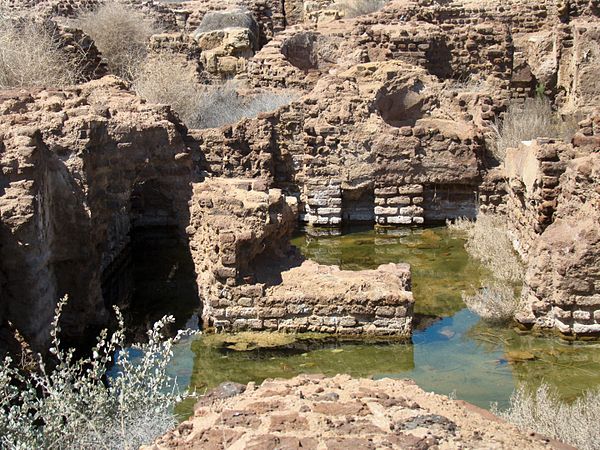
|
| Photo by Institute for the Study of the Ancient World, CC BY-SA 2.0, via Wikimedia Commons.
|
| The church, baptistry, basilicas, public buildings, streets, monasteries, houses and workshops in this early Christian holy city were built over the tomb of the martyr Menas of Alexandria, who died in 296. The site is inscribed on the List of World Heritage in Danger since 2001. The local soil, which is exclusively clay, is hard and capable of supporting buildings when in a dry state, but the rise of the water table can threaten the archaeological structures. The destruction of numerous cisterns, disseminated around the city, has entailed the collapse of several overlying structures.
|
|
この文章の一部もしくは全文はhttp://whc.unesco.org/en/news/158に掲載された「アブ・メナ」の記事の内容に依拠しています。CC BY-SA 3.0.ライセンス。
|
Syria: Site of Palmyra

|
| Photo by Associazione DecArch, CC BY-SA 4.0, via Wikimedia Commons.
|
| An oasis in the Syrian desert, north-east of Damascus, Palmyra contains the monumental ruins of a great city that was one of the most important cultural centres of the ancient world. From the 1st to the 2nd century, the art and architecture of Palmyra, standing at the crossroads of several civilizations, married Graeco-Roman techniques with local traditions and Persian influences. The site is inscribed on the List of World Heritage in Danger since 2013. The Arch of Triumph in Palmyra was destroyed in 2015 (this photo dates from 1993).
|
|
この文章の一部もしくは全文はhttp://whc.unesco.org/en/list/23の「パルミラ遺跡」の記事の掲載内容ならびに「ユネスコ世界遺産の4塔門建築の破壊と重大な被害を非難するユネスコ総裁の声明」http://whc.unesco.org/en/news/1620に依拠しています。CC BY-SA 3.0.ライセンス。
|
Libya: Old Town of Ghadamès

|
| Photo by Luca Galuzzi, CC BY-SA 2.5, via Wikimedia Commons
|
| Ghadamès, known as ‘the pearl of the desert’, stands in an oasis. It is one of the oldest pre-Saharan cities and an outstanding example of a traditional settlement. Its domestic architecture is characterized by a vertical division of functions: the ground floor used to store supplies; then another floor for the family, overhanging covered alleys that create what is almost an underground network of passageways; and, at the top, open-air terraces reserved for the women. The site is inscribed on the List of World Heritage in Danger since 2016. There is a high level of instability affecting the country, and the presence of armed groups can negatively impact this site.
|
|
この文章の一部もしくは全文はhttp://whc.unesco.org/en/list/362の「ガダミスの旧市街」の記事ならびに「危機に瀕するリビアのユネスコ世界遺産一覧の登録遺産5件」http://whc.unesco.org/en/nenews/1523の掲載内容に依拠しています。CC BY-SA 3.0.ライセンス。
|
Jordan: Petra

|
| Photo by Ian McKellar, CC BY-SA 2.5, via Wikimedia Commons.
|
Inhabited since prehistoric times, this Nabataean caravan-city, situated between the Red Sea and the Dead Sea, was an important crossroads between Arabia, Egypt and Syria-Phoenicia. Petra is half-built, half-carved into the rock, and is surrounded by mountains riddled with passages and gorges. It is one of the world's most famous archaeological sites, where ancient Eastern traditions blend with Hellenistic architecture. It is inscribed on the World Heritage List since 1985. The monuments are subject to ongoing erosion due to wind and rain, exacerbated in the past by windblown sand due to grazing animals reducing ground cover. They are also vulnerable to flash flooding along Wadi Musa through the winding gorge (Siq) if the Nabataean diversion system is not continually monitored, repaired and maintained. The property is under pressure from tourism, which has increased greatly since the time of inscription. Congestion points include the Siq, which is the main entrance to the city from the east. It is also vulnerable to the infrastructure needs of local communities and tourists.
|
|
この文章の一部もしくは全文はhttp://whc.unesco.org/en/list/362の「ペトラ」の記事の掲載内容に依拠しています。CC BY-SA 3.0.ライセンス。
|
Nepal: Bhaktapur Durbar Sqaure, Kathmandu Valley

|
| Photo by Alexander Shafir, CC BY-SA 3.0, via Wikimedia Commons.
|
| The cultural heritage of the Kathmandu Valley is illustrated by seven groups of monuments and buildings which display the full range of historic and artistic achievements for which the Kathmandu Valley is world famous. The seven include the Durbar Squares of Hanuman Dhoka (Kathmandu), Patan and Bhaktapur, the Buddhist stupas of Swayambhu and Bauddhanath and the Hindu temples of Pashupati and Changu Narayan. It was inscribed on the World Heritage List in 1979. The devastating 2015 Nepal earthquake and the aftershocks that followed have heavily damaged the monuments and sites within the Kathmandu Valley World Heritage property, as well as a large number of other cultural sites in the northwestern area of Nepal. The earthquake damaged and destroyed buildings in the Square pictured in this image, which was taken in 2010.
|
|
この文章の一部もしくは全文はhttp://whc.unesco.org/en/list/121の「カトマンズ盆地」の記事ならびに「ユネスコはカトマンズ盆地の世界遺産の再公開に安全性の問題を指摘」http://whc.unesco.org/en/news/1296の掲載内容に依拠しています。CC BY-SA 3.0.ライセンス。
|
India: Group of Monuments at Hampi

|
| Photo by Nagesh Thota, CC BY-SA 4.0, via Wikimedia Commons.
|
The austere, grandiose site of Hampi was the last capital of the last great Hindu Kingdom of Vijayanagar. Its fabulously rich princes built Dravidian temples and palaces which won the admiration of travellers between the 14th and 16th centuries. Conquered by the Deccan Muslim confederacy in 1565, the city was pillaged over a period of six months before being abandoned. It was inscribed on the World Heritage List in 1986.
The majority of the monuments are in good state of preservation and conservation. However, maintaining integrity poses significant challenges derived mainly from pressures associated with development, planned and unplanned, which pose a threat to the property, as well as encroachments and changes in land use, especially increased agricultural activity of commercial crops that might threaten the physical stability of the diverse monuments.
|
|
この文章の一部もしくは全文はhttp://whc.unesco.org/en/list/241の「ハンピの建造物群」の記事の掲載内容に依拠しています。CC BY-SA 3.0.ライセンス。
|
Yemen: Old Walled City of Shibam
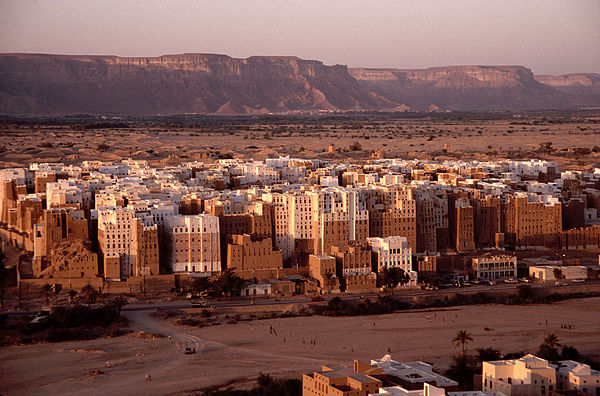
|
| Photo by Jialiang Gao, CC BY-SA 3.0, via Wikimedia Commons.
|
| Surrounded by a fortified wall, the 16th-century city of Shibam is one of the oldest and best examples of urban planning based on the principle of vertical construction. Its impressive tower-like structures rise out of the cliff and have given the city the nickname of ‘the Manhattan of the desert’. It is inscribed on the List of World Heritage in Danger since 2015, as it was under potential threat from the armed conflict, which compounds safeguarding and management problems already observed at the site. This photo was taken in 1999.
|
Italy: Ferrara, City of the Renaissance, its Po Delta

|
| Photo by Sailko, CC BY-SA 3.0, via Wikimedia Commons.
|
| Ferrara, which grew up around a ford over the River Po, became an intellectual and artistic centre that attracted the greatest minds of the Italian Renaissance in the 15th and 16th centuries. Here, Piero della Francesca, Jacopo Bellini and Andrea Mantegna decorated the palaces of the House of Este. The humanist concept of the 'ideal city' came to life here in the neighbourhoods built from 1492 onwards by Biagio Rossetti according to the new principles of perspective. The completion of this project marked the birth of modern town planning and influenced its subsequent development. It was inscribed on the World Heritage List in 1995. In May 2012, two major earthquakes occurred in northern Italy. This image of 'Sala dell'Aurora' of the Este Castle in Ferrara shows patches that were placed all along the areas where the fresco sustained damage.
|
|
この文章の一部もしくは全文はhttp://whc.unesco.org/en/list/733/の「フェラーラ:
ルネサンス期の市街と
ポー川デルタ地帯」の記事の掲載内容に依拠しています。CC BY-SA 3.0.ライセンス。
|
United Kingdom: St. Michaels Mount

|
| Photo by Fuzzypiggy, CC BY-SA 3.0, via Wikimedia Commons.
|
| In 2008 the National Trust reported that almost 200 miles of some of the most precious stretches of south-west England's coastline were threatened by rising sea levels, putting beaches, cliffs, harbours and buildings in danger to be lost forever. Within this "risk zone", among the 111 listed buildings is St. Michaels Mount, a civil parish linked to the town of Marazion by a man-made causeway of granite setts, passable between mid-tide and low water. Its Cornish language name – literally, "the grey rock in a wood" – may represent a folk memory of a time before Mount's Bay was flooded, indicating a description of the mount set in woodland
|
|
この文章の一部もしくは全文は英語版ウィキペディアに掲載された「セント・マイケルズ・マウント」の記事の掲載内容に依拠しています。CC BY-SA 3.0.ライセンス。
|
Panama: The Fortifications on the Caribbean Side of Panama: Portobelo-San Lorenzo

|
| Photo by Jim Williams, CC BY-SA IGO 3.0, via Wikimedia Commons
|
| Magnificent examples of 17th- and 18th-century military architecture, these Panamanian forts on the Caribbean coast form part of the defence system built by the Spanish Crown to protect transatlantic trade. The site is a key element to the understanding of the adaptation of European building models and their impact on the New World transformation during the modern era. This property demonstrates the strategic organization of the territory and represents an important concept of defence and technology development mainly between the 17th and 18th centuries. It is inscribed on the List of World Heritage in Danger since 2012. Environmental factors and uncontrolled urban sprawl and development are among threats to its integrity.
|
|
この文章の一部もしくは全文はhttp://whc.unesco.org/en/list/135「パナマのカリブ海沿岸の
要塞群 : ポルトベロと
サン・ロレンソ
(パナマ)」の記事の掲載内容に依拠しています。CC BY-SA 3.0.ライセンス。
|
Chile: Humberstone and Santa Laura Saltpeter Works

|
| Photo by Diego Delso, CC BY-SA 4.0, via Wikimedia Commons.
|
| Humberstone and Santa Laura works contain over 200 former saltpeter works where workers from Chile, Peru and Bolivia lived in company towns and forged a distinctive communal pampinos culture. That culture is manifest in their rich language, creativity, and solidarity, and, above all, in their pioneering struggle for social justice, which had a profound impact on social history. Situated in the remote Pampas, one of the driest deserts on Earth, thousands of pampinos lived and worked in this hostile environment for over 60 years, from 1880, to process the largest deposit of saltpeter in the world, producing the fertilizer sodium nitrate that was to transform agricultural lands in North and South America, and in Europe, and produce great wealth for Chile. Because of the vulnerability of the structures and the impact of a recent earthquake, the site was also placed on the List of World Heritage in Danger in 2015, to help mobilize resources for its conservation.
|
|
この文章の一部もしくは全文はhttp://whc.unesco.org/en/list/1178に掲載された「ハンバーストーンと
サンタ・ラウラの
硝石工場群」の記事の内容に依拠しています。CC BY-SA 3.0.ライセンス。
|
Cuba: Trinidad and the Valley de los Ingenios

|
| Photo by José Porras, CC BY-SA 3.0, via Wikimedia Commons.
|
Founded in the early 16th century in honour of the Holy Trinity, the city was a bridgehead for the conquest of the American continent. Its 18th- and 19th-century buildings, such as the Palacio Brunet and the Palacio Cantero, were built in its days of prosperity from the sugar trade. It was inscribed on the World Heritage List in 1988. The Valley de los Ingenios is a remarkable testimony to the development of the sugar industry. A living museum of Cuban sugar production, it includes the sites of 75 former cane sugar mills, plantation houses, barracks and other facilities related to this vulnerable industry, which has witnessed a gradual and progressive decline. The historical process of land degradation in the valley, one of the reasons for its decline (along with water shortages), has led to a decrease in the cultivation of sugarcane.
|
|
この文章の一部もしくは全文はhttp://whc.unesco.org/en/list/460に掲載された「トリニダと
ロス・インヘニオス渓谷」の記事の内容に依拠しています。CC BY-SA 3.0.ライセンス。
|
Mexico: el Día de los Muertos

|
| Photo by Jordi Cueto-Felgueroso Arocha, CC BY-SA 4.0, via Wikimedia Commons.
|
| As practised by the indigenous communities of Mexico, el Día de los Muertos (Day of the Dead) commemorates the transitory return to Earth of deceased relatives and loved ones. This period also marks the completion of the annual cycle of cultivation of maize, the country’s predominant food crop. This encounter between the living and the dead affirms the role of the individual within society and contributes to reinforcing the political and social status of Mexico’s indigenous communities. Recently wider interest in the commemoration has lead to cultural appropriation and commercialisation. Inscribed on the Representative List of the Intangible Cultural Heritage of Humanity in 2008.
|
Japan: Washi

|
| Photo by コヲダ, CC BY-SA 4.0, via Wikimedia Commons.
|
| The traditional craft of hand-made paper, or Washi, is practised in three communities in Japan: Misumi-cho in Hamada City, Shimane Prefecture; Mino City in Gifu PrefecTure; and Ogawa Town/Higashi-chichibu Village in Saitama Prefecture. The paper is made from the fibres of the mulberry plant, which are soaked in clear river water, thickened, and then filtered through a bamboo screen. Washi paper is used not only for letter writing and books, but also in home interiors to make paper screens, room dividers and sliding doors. Most of the inhabitants of the three communities play roles in keeping this craftsmanship viable, ranging from the cultivation of mulberry, training in the techniques, and the creation of new products to promote Washi domestically and abroad. Fewer than 350 families still engage in the production of Washi paper by hand. Inscribed on the Representative List of the Intangible Cultural Heritage of Humanity in 2014.
|
South Sudan: Kisra

|
| Photo by Mohamed Elfatih Hamadien, CC BY-SA 4.0, via Wikimedia Commons.
|
| Kisra is a popular thin fermented bread made in Sudan and South Sudan made from wheat or durra, also known as sorghum. There are two different forms of kisra: thin baked sheets, known as kisra rhaheeefa, which is similar to injera; and a porridge known as kisra aseeda or aceda. The bread-making, transmitted by participation within families, expresses hospitality, solidarity and certain beliefs that symbolize common cultural roots reinforcing community belonging. There have been several years of instability in food supply in South Sudan caused by war and drought. These factors have created food shortages affecting almost five million people, about 50% of the South Sudanese population.
|
Morocco: Jemaa el-Fna Square

|
| Photo by Luc Viatour, CC BY-SA 3.0, via Wikimedia Commons.
|
| The Jemaa el-Fna Square is one of the main cultural spaces in Marrakesh and has become one of the symbols of the city since its foundation in the eleventh century. It represents a unique concentration of popular Moroccan cultural traditions performed through musical, religious and artistic expressions. All through the day, and well into the night, a variety of services are offered, such as dental care, traditional medicine, fortune-telling, preaching, and henna tattooing; water-carrying, fruit and traditional food may be bought. Urbanization, in particular real estate speculation and the development of the road infrastructure, are seen as serious threats to the cultural space itself. While Jemaa el- Fna Square enjoys great popularity, the cultural practices may suffer acculturation, also caused by widespread tourism. Inscribed on the Representative List of the Intangible Cultural Heritage of Humanity in 2008 and on the World Heritage List in 1985.
|
Ecuador: Toquilla straw hat

|
| Photo by Hugo Gonzenbach, CC BY-SA 4.0, via Wikimedia Commons.
|
| The toquilla straw hat is woven from fibres of a palm tree that grows along the Ecuadorian coast. Coastal farmers cultivate the toquillales and harvest the stems before separating the fibre from the green outer skin. This is boiled to remove chlorophyll and dried for subsequent bleaching with sulfur over a wood fire. Weavers take this raw material and begin weaving the crown and the brim of the hat. Weaving a hat can take from one day to eight months, depending on the quality and finesse. Fewer than a dozen weavers capable of making the finest "Montecristi superfinos" remain. Production in Ecuador is dwindling, due to economic challenges in Ecuador and competition from mass production overseas. Inscribed on the Representative List of the Intangible Cultural Heritage of Humanity in 2012.
|
Norway: Oselvar

|
| Photo by Kjell Magnus Økland, CC BY-SA 4.0, via Wikimedia Commons.
|
The Oselvar was once western Norway’s main mode of transportation. Also used for recreation, the use and knowledge about wooden oselvar boats almost disappeared with the introduction of modern boats in the 1940s, greater road transport in the 1960s, as well as government price restrictions forcing builders to find alternative work. Awareness of the Oselvar heritage being at risk led to a coalition of organizations to recruit apprentice boat builders. This facilitates the transmission of expert know-how on building techniques (normally passed down from father to son), attracts active builders by providing them with infrastructure, and supports the oselvar manufacturing market.
So far, more than 85 boats have been built and 40 repaired. The tree used to create the boat in the picture was cut down by the father of the man rowing, giving the boat a special place in this family's heart. This safeguarding activity was included on the Register of Good Safeguarding Practices in 2016.
|
Iraq: Illegal excavation and looting

|
| Photo by UNESCO, CC BY-SA IGO 3.0, via Wikimedia Commons.
|
This image was taken in April 2017 during a UNESCO mission to Nineveh, Iraq (the Ancient City of Nineveh is on Iraq’s Tentative List – potential application for future World Heritage status), which was heavily destroyed and excavated by ISIS. Destruction of cultural heritage and archaeological looting is a global issue that threatens the preservation of our shared cultural heritage. Illegal excavations have exponentially increased due to the conflicts in the Middle East. Illegal excavation destroys the archaeological context of cultural objects, which is vital for uncovering information about the cultures and people who produced them.
Archaeological context gives an artifact a story, and connects it to the larger history of an ancient region. Looters systematically destroy the remains of civilizations in their quest for sellable artefacts. If these same artefacts were properly excavated, they could have provided very valuable historical and scientific information.
|
Iraq: Illicit Trafficking of Cultural Property

|
| Photo by U.S. Immigration and Customs Enforcement, CC0, via Wikimedia Commons.
|
Since 2003, and the heavy looting of the Baghdad National Museum, many artifacts from Iraq were discovered being sold on online e-commerce sites. Some of the sales were used by large transnational criminal organizations to launder money. A number of objects were seized, repatriated and returned to Iraq to be exhibited in the National Museum of Iraq in Baghdad. 15,000 artefacts have been looted from the Museum, but currently only 4,300 objects have been returned. Among the objects recovered was a 2,700- year-old head from a large stone sculpture of a lamassu, an Assyrian protective deity depicted as having a human's head, the body of an ox or a lion, and bird's wings. The statue was taken from the palace of the Assyrian king Sargon II, near Khorsabad, Iraq.
|
Mozambique: Illicit trafficking of underwater cultural heritage

|
| Photo by Ulrike Guerin, CC BY-SA 3.0 IGO, via Wikimedia Commons.
|
| A wreck of a ship, stranded on the beach of Mozambique Island. The ship was once used by treasure hunters in order to commercially exploit the underwater cultural heritage treasures off the coast of Mozambique. The photo was taken as part of a UNESCO community workshop for local organizations to protect the underwater cultural heritage of Mozambique Island in the framework of the 2001 UNESCO Convention.
|
Germany: Role and importance of documentation (importance of inventories)

|
| Photo by UNESCO, CC BY-SA IGO 3.0, via Wikimedia Commons.
|
| Inventory of the Vorderasiatisches Museum (Museum of the Ancient Near East) at the Pergamonmuseum, Berlin, Germany with the following information: Museum number, location, short description of the object with measurements and figure, site of discovery, provenance – for example partage or acquisition – and references. All these data are necessary for documenting the object’s 'biography’ and to identify the object should it ever be stolen.
|
Italy: Illicit Import, Export and Transfer of Ownership of Cultural Property
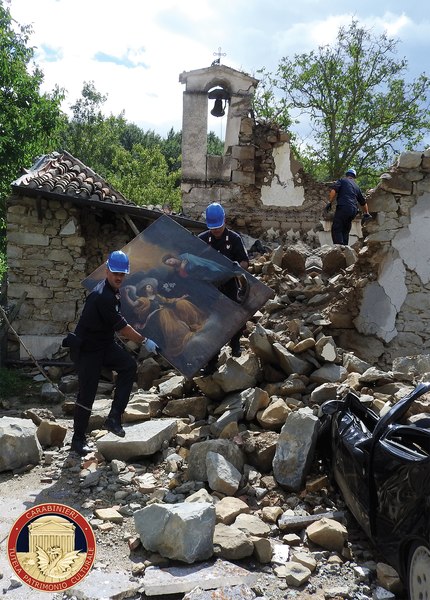
|
| Photo by UNESCO, CC BY-SA IGO 3.0, via Wikimedia Commons.
|
| A team from the Italian Carabinieri Department for the Protection of Cultural Heritage (TPC) recovers and secures a 17th century painting from the church of St Mary of the Annunciation in Cossito, Italy in 2016. The Carabinieri TPC supports international police cooperation via INTERPOL and UNESCO to stop the illicit trafficking of cultural property, and has also carried out support activities during peacekeeping operations (as in Iraq between 2003 and 2006).
The TPC department works in close cooperation with UNESCO and represents an international reference for many countries that seek to improve their policies and procedures for countering illicit trafficking of cultural objects. Twenty-six countries from all over the world have benefited from training courses for their police forces and customs agents.
|
Syria and Iraq: Illicit trade

|
| Photo by UNESCO, CC BY-SA IGO 3.0, via Wikimedia Commons.
|
| This image shows the damage of artefacts due to illicit trade at Palmyra, Syria. Today, the illicit trade in looted artefacts from countries such as Syria and Iraq represents an important source of income for terrorist groups. Cultural objects originating from the Middle-East are invaluable. The illicit trafficking of cultural property has become an international security issue. Thus, the international community has taken steps to denounce and curb this trade. Notably, the UN Security Council Resolution 2199 expresses concern that terrorist groups are generating income from engaging in the looting and smuggling of cultural property and thus requests States to impose a ban on the trade in cultural objects from Iraq and Syria.
|
Italy: The 2012 earthquake

|
| Photo by lucaphoto, CC BY-SA 4.0, via Wikimedia Commons.
|
| In May 2012, two major earthquakes occurred in Northern Italy, causing 27 deaths and widespread damage. The first earthquake, registering magnitude 6.1, struck in the Emilia-Romagna region on 20 May. On 29 May a magnitude 5.8 earthquake hit the same area. At least 100 structures of historical significance have been damaged or destroyed, and many churches in towns around the epicentre suffered damages. This pictures portrays the Church of San Felice Vescovo Martire, placed in San Felice sul Panaro, a little village close to Modena. This image was created as part of the Wiki Loves Monuments competition and became a well-known picture, representing the earthquake and the importance of the preservation of the cultural sites.
|
|
この文章の一部もしくは全文は英語版ウィキペディアに掲載された「イタリア北部地震」の記事の内容に依拠しています。CC BY-SA 3.0.ライセンス。
|
Kiruna Church
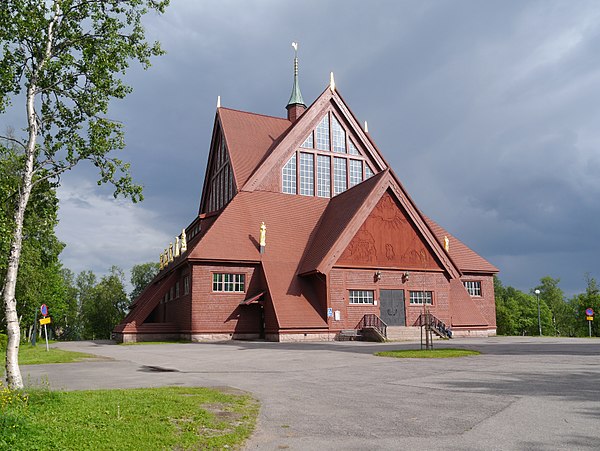
|
| Photo by Zairon, CC BY-SA 3.0, via Wikimedia Commons.
|
Kiruna church was built between 1909 and 1912, after drawings by architect Gustaf Wickman. The church, whose unique appearance is inspired by the Norwegian stave churches, stands in a nature park near Kiruna center. The church is one of Sweden's largest wooden buildings, and a unique building from the beginning of the 20th century. It is a protected Church Monument in Sweden. The building style is neo-Gothic, the interior has national romantic features and the composition of the altar is in art nouveau style. Kiruna church will probably need to be moved before subsidence from the ore mine in Kiirunavaara reaches it.
|
|
この文章の一部もしくは全文はスウェーデン語版ウィキペディアに掲載された「キルナ教会」の記事の内容に依拠しています。CC BY-SA 3.0.ライセンス。
|
































